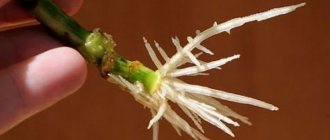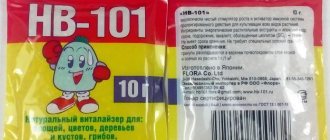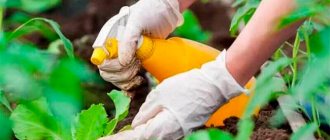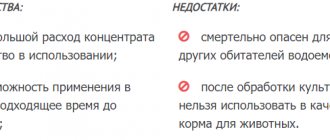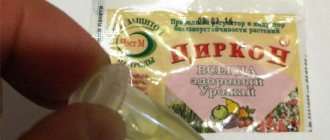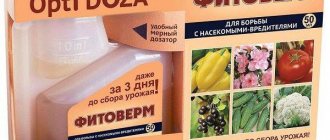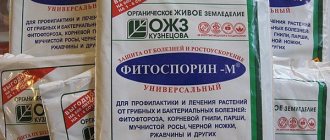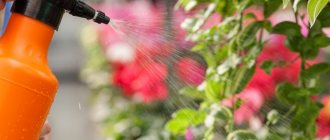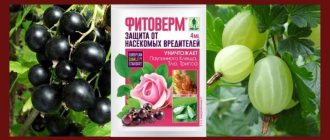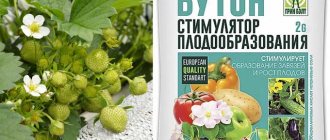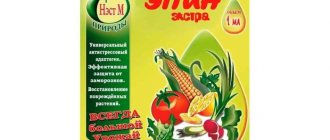Kornevin instructions for using the root growth stimulator, described in this article, allows you to strengthen the immune system of plants and accelerate their root formation. Kornevin for plants is an analogue of heteroauxin , which many classify as fertilizers. However, this is not so, Kornevin is not a fertilizer, since in using it instead of mineral, organic, bacterial fertilizers. Next, we’ll talk about the properties of the biostimulator and how to use it.
Composition and release form, description of the drug
It has the same effect as heteroauxin (considered its analogue), however, the effect appears more slowly, but lasts longer. Kornevin's composition includes indolylbutyric acid, its preparation contains 5 g per 1 kg, and microelements: phosphorus, potassium, molybdenum and manganese. The drug for sale is packaged in bags of 4.5, 10, 125 g and packages of 250 g. Inside they contain a fine white or light beige powder.
Rooting grape cuttings
For rooting grape cuttings, kornevin is used both dry and diluted in water. This crop is quite easily propagated by cuttings, but if there is very little planting material or the variety is especially valuable, you should play it safe and use a root former.
The dry method is more reliable, it will require more powder consumption and is dangerous with the possibility of rotting of the cuttings. It is used if the selected variety does not take root in the solution. The dry method is used if, after 2 weeks of rooting in solution, callus formation has not occurred. The cutting should be carefully examined under a magnifying glass: if even microscopic growths are noticeable, it should be left in an aqueous solution.
What is it intended for and the principle of operation
It is a root former for cuttings, tree seedlings, seedlings and bulbs. The action of the drug is as follows: when indolylbutyric acid gets on the surface of the stems or part of the cut cuttings, it irritates the top layer of tissue, causing callus to form on them, from which roots grow. Callus formation is a natural process, but Kornevin only accelerates it.
The drug Kornevin improves the rooting of cuttings and seedlings of fruit and ornamental bushes, trees, grapes, and accelerates the survival of cuttings and seedlings after transplantation. Kornevin, when picked, helps seedlings to take root faster.
The speed of action of the drug is 20-60 days, it is determined by the period of its decomposition to endogenous auxin, which varies depending on the conditions in which the drug is stored.
Kornevin cannot be considered a fertilizer; its active substance, which belongs to phytohormones, does not nourish plants, cannot protect them from diseases or pests, the drug is not intended for this. Therefore, you cannot rely only on it and neglect standard fertilizers and protective agents.
Dry application
Many people use the drug not only in liquid form, but also in powdery consistency. The use of dry matter requires caution and increased attention to protecting the body from the influence of the components of the chemical.
The main requirement when working with any chemicals is compliance with safety precautions. Wear gloves, a gauze mask, goggles, and protective clothing so that the powder does not accidentally get into the eyes, the mucous membranes of the nose and mouth, or the surface of the skin.
Kornevin is applied in small portions: a small amount to the place where the cutting or leaf is cut. The treated base is placed in the soil for further rooting and growth of the young flower.
The remaining drug is poured into a jar, closed, and a label is attached with the name and expiration date of the substance. It is important to store the growth stimulator in a dark place, away from food and medications.
Advantages and disadvantages of Kornevin
Like any product, it has advantages and disadvantages. The advantages of using Kornevin include:
- effect on all types of trees, bushes, flowers and vegetables, even those that are difficult to root;
- you can speed up rooting: in the spring of seedlings or in the fall of seedlings, so that they take root faster and are not exposed to cold or heat with undeveloped roots;
- you can save plants during transplantation if it is urgently needed;
- greater effect from the drug than from honey and yeast, which contain natural auxins.
The disadvantages are the following: Kornevin’s aqueous solution may be weak, and root growth will be slow, then you need to use dry powder. In this case, you need to monitor the consumption rate; if you overdose, then, on the contrary, it will have a depressing effect on the roots.
We recommend reading
Instructions for use of the drug Epin extra
Instructions for using succinic acid for plants
How to use boric acid in the garden
Rules for the use of copper sulfate in gardening
Precautionary measures
- To dilute the drug in water, use glass or glazed ceramic containers without pores in which it can remain. Or disposable plastic tableware
- When diluting the powder in water, do not smoke, drink, or eat. And don't do it in other family members' dining area.
- If the drug gets on your hands, wash them immediately with soap.
- If Kornevin accidentally enters the body (a solution of the drug in water ready for irrigation was drunk), immediately wash it down with a large amount of warm water or a weak (pale pink) solution of potassium permanganate to induce vomiting. Take activated carbon at the rate of 1 tablet/10 kg of body weight.
- Keep the drug out of the reach of children and pets.
Instructions for use
This is a simple substance; to reveal the effect, it does not need to be mixed with anything other than water.
Dry
Kornevin is used in dry and dissolved form. If you choose the dry powder method, then you just need to powder the roots of seedlings or seedlings, cuttings of grapes and other plants before planting. The lower part of the cuttings is moistened and sprinkled with the preparation. For 1 cutting you will need 10-20 mg of the substance.
Kornevin for indoor flowers, especially exotic and therefore finicky ones, can be dangerous. It is better not to use it for orchids (but if you really want to try it, then use it dry, dusting it a little with a brush, a small amount, only the root collar). The preparation is also suitable for violets. It is much easier to root the plucked leaves of this plant. The same can be done with cuttings of begonia, gloxinia, etc. You should not dip them heavily into the powder, just lower them to a depth of 1 cm, this is enough for the roots to grow. If a lot of powder has stuck, shake off the excess.
As a solution
To use Kornevin in the form of a solution, dissolve 1 g in 1 liter, stir for 3-5 minutes until all grains dissolve. Soak plants or seedlings in it for 6 hours before replanting. The second option is to water them 10 days after planting. Pour 0.5 liters per specimen. Kornevin should be diluted for watering seedlings in the same proportion as for cuttings. Do not soak it, but water it on the day of transplantation. The biostimulator Kornevin will help root the bulbs of ornamental crops. Before planting, they are soaked in the solution for 18 hours.
2-2.5 liters of liquid are poured under fruit tree seedlings so that they can grow roots. For bushes - 0.3 l, for seedlings of tomatoes, cucumbers, strawberry rosettes or other vegetables - 50-60 ml per 1 copy. For flowers, for example, for petunia - 30-40 ml. Indoor flowers can be watered when transplanting from pot to pot, and garden flowers, for example, chrysanthemums, when planting in flower beds in spring. Kornevin is especially useful for conifers, which usually take root quite difficult. Gardeners recommend Kornevin for roses, when replanting a bush and for the same cuttings.
When diluting, it is important to remember that there is 1 gram of this substance in a teaspoon. It is better to dilute Kornevin in warm water, it dissolves faster in it.
Compatibility with other chemicals
The substance is compatible with many drugs used in domestic floriculture. This series includes other insecticides and fertilizers.
For greater safety, perform the following check: a small amount of drugs that you will use together is mixed. If you shake the mixture and do not get any sediment, sharing it is acceptable. If a precipitate forms, do not mix these drugs; you will not get the desired result.
Reviews
Gardeners who remember to use Kornevin for plants leave such reviews.
I always buy this product for rooting cuttings. It is inexpensive, comes in convenient small packages, is used well, and there are almost no leftovers. You need to dilute the substance and keep plants in it as written in the instructions, the main thing is not to exceed the dosage. Sylvester
The use of Kornevin for seedlings has repeatedly given positive results. Processed tomatoes and cucumbers take root much faster, this is especially noticeable if the weather is unfavorable. If you use Kornevin for cuttings, they will take root much more actively than unsoaked ones, this can even be seen visually: the roots are longer, there are more of them, so the drug works. It helps plants during one of the most important stages of their life. Anatoly
You can water anything with Kornevin during planting or replanting. It is also suitable for seedlings, vegetable seedlings, flower crops, flower bulbs, and rose cuttings. They all react very well to him. I didn't notice any harm from it. Sergey
Useful properties of the substance for indoor plants
Note to flower growers:
- The drug stimulates cell division and the active development of roots in flowers, which has a positive effect on susceptibility to diseases.
- Indoor flowers can more easily tolerate unfavorable conditions.
- Under the influence of the active substance, rooting of cuttings, shoots, leaves, and bulbs occurs.
- When used correctly, orchids grow a new aerial root system.
For more active seed germination, planting material can be placed in Kornevin solution for 20–30 minutes.
Content
- Purpose and areas of application
- Composition and dosage form
- Mechanism of action
- Application regulations
- a) Dust with dry powder
- b) Soaking the root system
- c) Watering at the root
- Compatibility
- Restrictions and safety measures
- Analogs of the drug "Kornevin"
- As a conclusion
“Kornevin” has been successfully used in crop production for decades as a regulator/activator of root formation. Its areas of application are wide: growing seedlings, planting seedlings, cuttings, and many others. etc.
Within the framework of this material, we will consider in detail the composition and mechanism of action, areas and regulations of use, compatibility, analogues, etc.
How to root a rose from a bouquet using root
Sometimes green buds form on the stems of roses from a bouquet in place of torn leaves. If you like the variety, you should try rooting the cuttings. To do this, the stem is cut off at the bottom and top, leaving 3 healthy swollen buds.
The lower part of the stem from the cut to the lowest bud is scratched with a sharp knife to make it easier for the roots to germinate. Then this place, including the cut and the lower bud, is dipped in the root, and after a few minutes the excess is shaken off and the cutting is planted in a planting container. The top two buds should remain on the surface. It is advisable to use special soil for roses.
Cover the top of the container with polyethylene or cover it with a transparent plastic glass and place it in a warm, bright place. From time to time, the shelter is removed for ventilation and, if necessary, the soil is moistened.
To root roses, experts advise using rootin together with zircon.
If there are still living cuttings from the bouquet, you can try rooting them in an aqueous solution of the drug. Planting material is prepared in the same way as for dry rooting. Only the lower bud of the cutting should remain in the water.
Treatment of planting material by Kornevin
| culture | How to prepare the solution | Dosage and treatment time |
| Root vegetables, tubers, bulbs | 5 g/5 l, dilute in warm water | 18 hours |
| Fruit tree seedlings | 5 g/5 l, dilute in warm water | 2 liters for each tree |
| Raspberries, gooseberries, currants, etc. | 5 g/5 l, dilute in warm water | Under-barrel or hole watering during planting, 2 liters each. |
| Vegetables | 5 g/5 l, dilute in warm water | Root watering, 50 ml |
| Flowers and ornamental grasses | 5 g/5 l, dilute in warm water | Watering over areas or 40 ml at the root |
Kornevin is best used in those cases and for those plants that are difficult to take cuttings under normal conditions. From garden ones these are cherry, plum, quince, pear. Among the domestic flowers - ivy-leaved geranium, or an ampelous type of pelargonium, which grows in the form of a vine with lashes up to 1 meter long.
Rooting of conifers (pine, blue spruce, juniper)
For cuttings of these trees and shrubs, two-year-old shoots are taken. They look like a cross-shaped branch with two side shoots at the end. These side ones are cut off, 5-7 cm of the lower part is cleared of needles and shallow 2-3 scratches are made along the bark, into which Kornevin is rubbed.
Before treatment with Kornevin, coniferous branches are kept in water (can be filled whole) at a temperature of 18-20 degrees.
Then the root-treated seedlings are stuck into planting pots, which can be made from cut plastic transparent untinted 3-liter bottles at an angle of approximately 30⁰. The bottles are cut 1/3 from the bottom, filled with drainage (1-2 cm), soil with peat (10-12 cm) and washed and dried river sand (5 cm).
The seedling is then covered with the cut off top of the bottle for a greenhouse effect - this is why you need to take a transparent bottle, this will ensure normal light conditions.
It is better to keep the rooted seedling on the balcony until autumn, protecting it from direct rays of the sun.
It is better to plant seedlings in the spring, and in the fall transplant them into open ground, only covering them with polyethylene for the winter.
